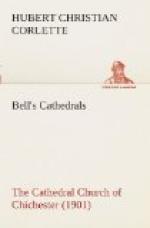Close by the parapet of the aisle the square angles of each buttress are cut off so as to form a base for the octagonal pinnacle above. These, when in their complete state, were undoubtedly very beautiful; for besides what can be now seen, it is known that they were once completed each with a spirelet. Now they have the substitutes suggested by parsimony to cover their incompleteness. As they are, in their ruined condition, it may be seen that they were not all finished in identically the same way. The three sides on the north of the octagon of each one are left plain and flat. The other five sides are treated as narrow, recessed panels, formed by the six groups of small shafts at either angle. Every group has its capital and moulded base. The capitals in some cases are carved, in others moulded only. Above each capital is a small carved boss. This, doubtless, was the stop to some member on the angles of the spirelets. Springing from the capitals are moulded and cusped arches, which form on either side the heads of the panelled divisions. The horizontal part of the weathering of the flying-buttresses is stopped behind the octagons of the pinnacles.
The parapet has a plain weathered coping, close under which is a string-course which helps to throw the water clear from the top of the wall; and two coupes below this one is another moulded string. Each is about six inches in depth. If is not possible to state more concerning these parts in detail, since they have been much repaired at various times.
The stove-pipes which run up the north and south sides of the nave as smoke-flues for the heating-apparatus do not add to the beauty of the exterior.




